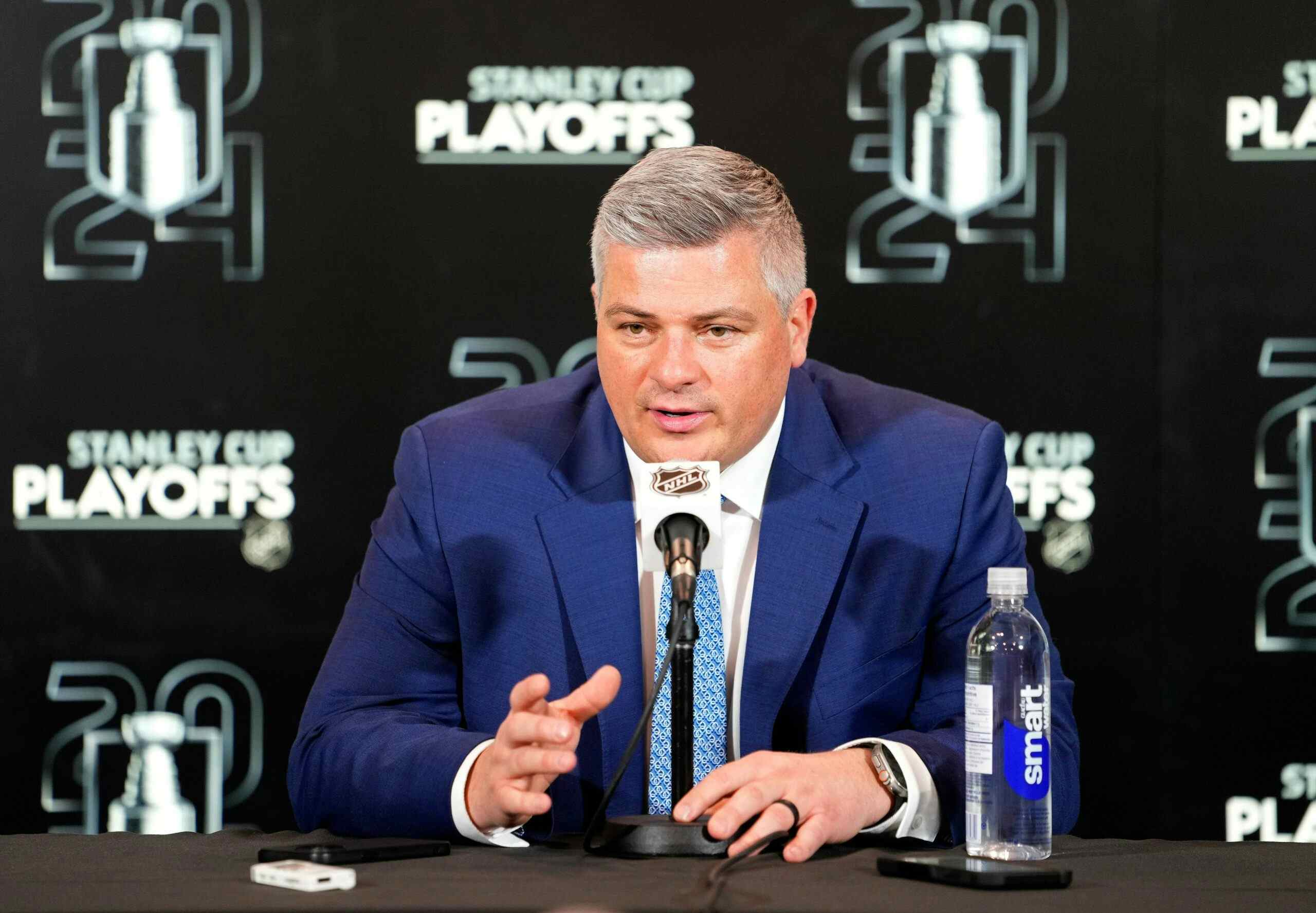Should the Leafs be running a “Top-9” offence this season?

Photo Credit: Robert Mayer/USA TODAY SPORTS
As the season approaches, fans and media have begun to dissect the remains and additions of this year’s roster while wondering where everybody should be placed. The most important question to many, of course, is how the top two lines stack up.
But in asking that, it’s possible that we’re looking into a less-than-optimal situation if we’re limiting the Leafs to a top-six, bottom-six team. Perhaps, with the coming injection of youth, the team should be looking towards more of a top-nine, bottom-three layout.
The logic behind a Top 9
One doesn’t have to spend much time splitting the atom to plead the case for running three lines instead of two. Obviously, the level of talent on your roster has to match (aka, you need at least a Top Six with no undeserving players), but once you hit that point, the philosophy comes with its incentives.
- A third threatening trio makes line matching much harder for your opponents. The common train of thought is that playing against weaker opponents makes your life easier, your odds of having the opportunity to consistently match against anyone are very slim. If your team has the depth to stand spread its skill across lines without leaving the top groups too weak to compete, you set yourself up for more opportunity to get a skilled line out against the opposition’s closer-to-replacement level talent.
- Short-term stamina comes into play. By spreading minutes over the course of a game, you ensure that your most capable forwards still have gas left in the tank in late-game situations, which could come key in close-score situations, be it in defending a lead, attempting to come back, or, in the case where you’d most need it, in overtime.
- Spreading even-strength minutes also ensures that your more special-teams oriented players aren’t over-worked in a game where the referees lean in on the whistle with a bit more lung-weight than usual.
- There’s also a long-term benefit too. By decreasing the high-intensity bursts over the course of the season, you minimize wear and tear on players. This ensures that your talent is as effective in April as they were in October, and can do wonders in helping prevent certain injuries.
- While there’s still some debate about the strategy, there is some belief that teams might be best off with a “displacer” flanking one of the wings; a legitimately capable forward who excels on the forecheck and along the boards to restore and maintain possession in situations that would otherwise lead to an opposing breakout. We had a post along those lines after the Matt Martin signing; I don’t know if I totally feel that Martin is a skilled enough displacer to play with the team’s most skilled forwards, but you look at players like James van Riemsdyk and Leo Komarov and you can see the potential for using that layout.
Around the League
Out of curiosity, I looked at the minutes that the league’s nine highest-scoring teams at 5-on-5 gave their forwards. Specifically, I wanted to see what percentage of an average game’s even strength time teams were giving their first, second, third, and fourth lines. Here’s what I came up with.
| Rk | Team | 1st FWD | 3rd FWD | 6th FWD | 9th FWD | 12th FWD |
|---|---|---|---|---|---|---|
| 1 | Washington Capitals | 33.32 | 31.61 | 28.44 | 24.19 | 17.5 |
| 2 | New York Rangers | 32.07 | 28.03 | 27.56 | 24.16 | 22.32 |
| 3 | Dallas Stars | 33.69 | 30.63 | 27.44 | 24.03 | 21.86 |
| 4 | Pittsburgh Penguins | 34.35 | 31.16 | 28.94 | 25.02 | 21.83 |
| 5 | Florida Panthers | 31.64 | 30.42 | 28.43 | 23.98 | 21.52 |
| 6 | Boston Bruins | 32.35 | 30.57 | 27.98 | 25.17 | 19.42 |
| 7 | New York Islanders | 34.31 | 28.91 | 26.66 | 24.44 | 21.28 |
| 8 | Calgary Flames | 33.72 | 28.22 | 27.10 | 23.68 | 22.78 |
| 9 | Tampa Bay Lightning | 33.23 | 30.05 | 29.52 | 26.34 | 22.56 |
The players who ate up huge shares of their teams’ ice time weren’t shocking; they were the superstars big enough to break out of typical usage to be double-shifted into big situations, or stay on for extra time at the conclusion of a powerplay or penalty kill. Players who played 33% or more of their team’s even strength minutes in an average game included Alex Ovechkin, Tyler Seguin, Sidney Crosby, John Tavares, Johnny Gaudreau, and Steven Stamkos.
After that, though, you see an interesting thing; most of these teams are pretty good about spreading their minutes. Only Dallas (89.6%) and Washington (89.9%) don’t give at least 90% of the third-most used forward’s ice time to their sixth-most used, and only Florida (84.3%) doesn’t give at least 85% of the sixth-most used forward’s minutes to their ninth-most used.The Rangers, Stars, and Flames all break 87% in that regard, the Bruins and Lightning break 89, and the Islanders hit a whopping 91.7%.
What’s key is that while these are some of the most skilled teams in the league, it isn’t just a matter of pure overflow. The star players might be at the top, but you can see some degree of talent spreading; things like Andre Burakovsky’s jump to Washington’s second line, Rick Nash playing with a bevy of different talents with the Rangers, Mattias Janmark playing with Jason Spezza and Valeri Nichushkin in Dallas while Ales Hemsky hangs out on the third line… you can hit pretty much every team on this list and find a similar scenario.
The most famous example of line spreading this year, of course, belongs to the Pittsburgh Penguins in the playoffs. Sidney Crosby played a whopping 33.97% of Pittsburgh’s available Even Strength minutes, but after that, there are five players in the 28.4-29.6% range (Malkin, Hornqvist, and the HBK line). Kunitz and Sheary trail not too far behind at ~26%, followed by a tail-off. Many feel that Pittsburgh’s spreading of the superstars was key to their success in the playoffs.
Would Babcock Do It?
All signs point to yes. While it is a best-on-best tournament with an overloaded roster that you can’t really go wrong with, a quick look at his present Team Canada lines shows that his four most offensively skilled players (Crosby, Stamkos, Tavares, and Seguin) are all spread across the lineup. As the realities of the salary cap became more clear in Detroit, he began to separate Pavel Datsyuk and Henrik Zetterberg, and in his last year, there was a lot of mixture in a group that included Datsyuk, Zetterberg, Abdelkader, Nyqvist, Helm, Tatar, Shehan, Jurco, and Glendenning. While not quite three equal lines, the direction was certainly being inched towards.
Here’s how the Leafs’ ice time shares looked for their top 14 regular forwards last season under Babcock:
| Player | individual TOI | team TOI | avg iTOI | avg tTOI | Share |
|---|---|---|---|---|---|
| Nazem Kadri | 1180.48 | 3866.87 | 15.53 | 47.16 | 32.94 |
| James van Reimsdyk | 598.47 | 3866.87 | 14.96 | 47.16 | 31.73 |
| Tyler Bozak | 822.77 | 3866.87 | 14.43 | 47.16 | 30.61 |
| Leo Komarov | 934.33 | 3866.87 | 13.95 | 47.16 | 29.57 |
| William Nylander | 299.45 | 3866.87 | 13.61 | 47.16 | 28.86 |
| PA Parenteau | 1035.22 | 3866.87 | 13.44 | 47.16 | 28.51 |
| Nick Spaling | 433.98 | 3866.87 | 12.4 | 47.16 | 26.29 |
| Joffrey Lupul | 563.63 | 3866.87 | 12.25 | 47.16 | 25.98 |
| Daniel Winnik | 681.28 | 3866.87 | 12.17 | 47.16 | 25.8 |
| Colin Greening | 358.05 | 3866.87 | 11.94 | 47.16 | 25.31 |
| Peter Holland | 772.7 | 3866.87 | 11.89 | 47.16 | 25.21 |
| Shawn Matthias | 592.4 | 3866.87 | 11.62 | 47.16 | 24.63 |
| Brooks Laich | 240.47 | 3866.87 | 11.45 | 47.16 | 24.28 |
| Michael Grabner | 900.1 | 3866.87 | 11.25 | 47.16 | 23.86 |
Toronto’s “balance” actually appears to be tighter than the other teams we looked at; while most have their ninth most used forward playing about 24% of the minutes, Daniel Winnik approaches nearly 26, and all 14 are at around 24. The Leafs are an outlier in a situation like this, though; they have so many players that came in and out of the lineup due to injuries and trades that you’d be hard-pressed to find a member of the team who didn’t get to play big minutes on a couple of nights.
Looking at lines that did manage to stick together for more than 100 minutes at a time, the lean is ultimately a bit closer to a top/bottom six, mostly due to the team’s lack of depth at centre. Nazem Kadri and Tyler Bozak both had many different players flank them for stretches, but until Nylander and Laich were brought in late-season, there wasn’t exactly a ton of reason to trust Nick Spaling with an offensive workload.
With the addition of Auston Matthews and the potential to slot Nylander or Mitch Marner at centre in the event of injury or a transaction, it would be of no surprise to see the Leafs become more reliant on that third line. In fact, Babcock has already said that Matthews will start the year there with Nylander on his right wing, thogh we’ll see how long that lasts, and what the definition of a third line really is.
The Top 9 Starter Kit
So if the Leafs went with a top nine, who would even be on it? Here’s a look at a couple of pairs of forwards that could be used. Keep in mind that this isn’t my own personal order; I’ve simply attached “Matthews at 3” to the minute assignments of Kadri and Bozak from last season.
| Left Wing | Centre | Right Wing |
|---|---|---|
| Nazem Kadri | Mitch Marner | |
| James Van Riemsdyk | Tyler Bozak | |
| Auston Matthews | William Nylander |
As for how the pairs came to be, there’s not a gigantic level of research here either. We’re running with the Nylander quote on line three, JVR and Bozak have a lot of ice time together, and now that Kadri has been talking more and more about being a mentor and leader, I’m intrigued as to how much help he could be to Marner, soon to be a fellow ex-Knight who was looked down on for his size but carries an abundance of skill and a bit of a pesty side as well. All three lines have centres who can carry the puck (something we learned about Bozak last year), and a winger who can create opportunities.
From there, it’s a matter of plugging in your third wheels. Leo Komarov, Colin Greening, and Milan Michalek are the runaway candidates as far as veterans go, though it’s possible that the team sees more in Martin that we do, or that they go full rogue and move Holland to higher left wing slot. Keeping these as more replaceable roles is good in the long term as well; while there may not be a ton of room for other young players like Connor Brown, Josh Leivo, Nikita Soshnikov, or Kerby Rychel to make the team out of camp; these are lineup spots that they could potentially jump into as the year progresses.
Theoretically, you could almost argue that this organization has the depth for a proper, legitimate top twelve; though the drop in skill level from a Matthews, Kadri, or Bozak to a Brooks Laich or Byron Froese is probably a significant enough one that the minutes will see a dive. Instead, they’ll likely settle for a stronger-than-most fourth line that can wait out the clock more proficiently than most other teams.
While the Leafs will no doubt be looking to their watches awaiting the moments where the big three blossom into minute-eating stars, scattering the array of “good enough” talent that the team presently possesses might be an effective way of keeping the energy and momentum going in situations where other teams may start to flame out. It’ll be interesting to see if that’s the direction the team goes come October.
Recent articles from Jeff Veillette





